How have the rights guaranteed to Americans changed over time?
Historically, civil rights in the United States and Iowa have been protected and constrained based on citizenship, sex, the construct of race, and other factors. Civil rights are personal rights guaranteed and protected by the U.S. Constitution and by federal laws enacted by Congress, such as the Civil Rights Act of 1964 and the Americans with Disabilities Act of 1990. State legislatures and state court decisions can also affect civil rights. Civil rights laws enacted by states and federal governments prohibit discrimination on the basis of race, color, national origin, disability, age, sex, and, in some cases, religion.
Early America
The Declaration of Independence stated “that all men are created equal, that they are endowed by their Creator with certain unalienable Rights, that among these are Life, Liberty and the pursuit of Happiness.” The concepts of life and liberty are generally understood, and the founders viewed the “pursuit of happiness” as that which was for the common good of society. Additionally, they believed these rights only applied to certain men. Legislatures and courts have at times interpreted the U.S. Constitution to limit or expand civil rights. As there is no scientific basis for denying rights, the social construct of race was used as a primary means of denying civil rights in the U.S. colonies and United States. In 1705, the white men making laws in the colony of Virginia established legislation stating enslaved people, Indians, and “mulattoes” were property, the same as cattle and other livestock. Eight decades later, in order to make sure states would ratify the Constitution, the founders protected the enslavement of Black people across the country, in both northern and southern states.
Though the Constitution was supposed to protect the property of U.S. citizens, the rights of American Indians were not protected. The Indian Removal Act was signed into law by President Andrew Jackson on May 28, 1830, authorizing the president to grant lands west of the Mississippi in exchange for Indian lands within existing state borders. This law was also the basis for the eviction of the Ioway, Sauk, Meskwaki, and other Native people from what would become Iowa.
Many states passed civil rights laws in the 1880s to protect equality based on race. Iowa passed a law in 1884 that provided, “All persons within this state shall be entitled to the full and equal enjoyment of the accommodations, advantages, facilities, and privileges of inns, restaurants, chophouses, eating houses, lunch counters, and all other places where refreshments are served, public conveyances, barber shops, bathhouses, theaters, and all other places of amusement. Any person who shall violate the provisions ... shall be guilty of a misdemeanor.” In practice, this law was rarely enforced and many businesses continued to discriminate against Blacks, American Indians, people with Asian Asian or Latin American ancestry.
20th Century
In the 1900s, equal protection, voting rights and educational equality became the focus of the civil rights movement. The U.S. Supreme Court case of Plessy v. Ferguson (1896) institutionalized the policy of separate but equal facilities for non-Whites, especially Blacks. In truth, few instances provided equal treatment and many Blacks fought against the practice from the start. The National Association for the Advancement of Colored People (NAACP) filed lawsuits in many cases arguing that separate schools were inherently unequal. In the unanimous U.S. Supreme Court decision of Brown v. Board of Education of Topeka, Kansas (1954), it became illegal to maintain segregated public schools.
One of the most regrettable violations of civil rights in United States’ history is the internment of more than 110,000 Japanese Americans during World War II. Following the attack on Pearl Harbor by Japan, a federal policy permitted the seizure of the property of U.S. citizens of Japanese ancestry and sent them to internment camps in Colorado, Wyoming, Arizona, Idaho, Arkansas, Utah, and California.
Voting rights became an increased civil rights focus in the 1910s and 1960s. States controlled voting rules and most barred women from voting into the 1910s. The 19th Amendment, ratified in in 1920, stated, “The right of citizens of the United States to vote shall not be denied or abridged by the United States or by any State on account of sex.” Blacks had been the subject of voter suppression through taxes and tests administered by racist election officials, especially in southern states. The Freedom Summer of 1963 was a voter registration effort in Mississippi. The national outrage coupled with a March on Washington and assassination of President John Kennedy led to the passage of the Civil Rights Act of 1964 and Voting Rights Act of 1965.
Marriage equality has also been viewed as a civil rights issue over the past fifty-five years. In Loving v. Virginia (1967), the U.S. Supreme Court ruled that the Virginia law violated the Due Process Clause of the Fourteenth Amendment. "Under our Constitution," wrote Chief Justice Earl Warren, "the freedom to marry, or not marry, a person of another race resides with the individual, and cannot be infringed by the State." Marriage equality for LGBTQ+ people in the United States was guaranteed in 2015 case of Obergefell v. Hodges.
New Millenium
The Americans with Disabilities Act (ADA) was signed into law in 1990, following many years of advocacy by the disability and civil rights communities. The ADA was modeled after the Civil Rights Act of 1964, which prohibits discrimination on the basis of race, color, religion, sex, or national origin and was introduced by Iowa Senator Tom Harkin.
Civil rights continue to be debated in legislatures and court houses across the nation. In a 5-4 decision in 2013, the U.S. Supreme Court invalidated a provision of the 1965 Voting Rights Act that required the states of Alabama, Alaska, Arizona, Georgia, Louisiana, Mississippi, South Carolina, Texas and Virginia receive congressional approval to make voting law changes. Legislators in Washington and Colorado have created expansive mail-in voting systems while other states remain resistant to this strategy. Policies such as “Stop and Frisk,” and higher rates of incarceration of Black people and other people of color are points of concern of racial profiling by law enforcement. Student speech continued to be an issue before the Court, as the judges heard a Pennsylvania case in 2021 related to profanities in a SnapChat video and a student’s suspension. The court upheld the student’s right to free speech outside of school stating that her punishment of suspension from cheerleading for a year was too severe.
Supporting Questions
How did the Framers of our early government understand civil rights?
- The Ancient Rights and Liberties of Great Britain, 1689 (Document)
- Two Treatises of Government, 1689 (Document)
- Virginia Declaration of Rights, June 1776 (Document)
- Declaration of Independence, July 1776 (Document)
- The Federalist Papers, #84, 1788 (Document)
- Bill of Rights, 1791 (Document)
How have individual Americans and civic groups taken steps to expand civil rights?
- Am I Not a Man and a Brother?, 1837 (Image)
- Sojourner Truth, Ain’t I a Woman? 1851 (Document)
- An account of the proceedings on the trial of Susan B. Anthony on the charge of illegal voting at the Presidential election in Nov., 1872 (Document)
- Suffrage Parade, 1913 (Image)
- Delegation representing 20,000 Californian Indians meeting with Senator Hiram Johnson, 1922 (Image)
- Americans with Disabilities Act Anniversary, 2005 25:20 minutes - 27:45 minutes (Video)
How has the idea of who deserves civil rights changed over time?
- 15th Amendment, 1871, (Image)
- Iowa flag, 1918 (Image)
- Four Freedoms to Congress, 1943, (Image)
- President Lyndon Johnson: Remarks upon Signing the Civil Rights Bill, 1964 (Video)
Civil Rights in the United States Teaching Guide
Suffrage Parade, 1913
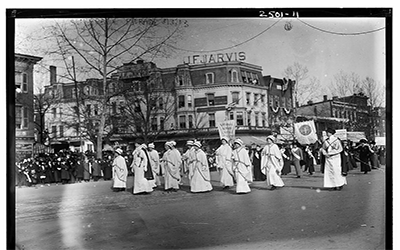
Description
One of the strategies used by those fighting for women to get the right to vote was holding parades. Marchers in the parades carried signs, rode on floats and horses in order to gain popularity for their movement.
Two Treatises of Government, 1689

Description
John Locke, author of Two Treatises of Government, was one of the important influences on the writers of America’s founding documents. His political philosophy encouraged readers to overthrow any government that did not protect the rights of its citizens. Locke also…
Delegation representing 20,000 Californian Indians meeting with Senator Hiram Johnson, 1922
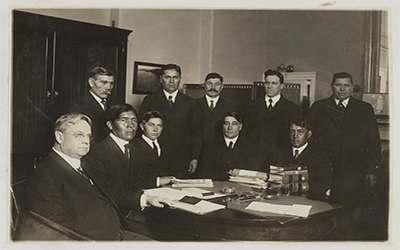
Description
Treaties between the United States government and American Indian tribes have been broken numerous times. In 1922, eight men, representing 300 tribes, met with United States Senator Hiram Johnson. The goal of the representatives was to petition Congress to recognize and…
Virginia Declaration of Rights, 1776
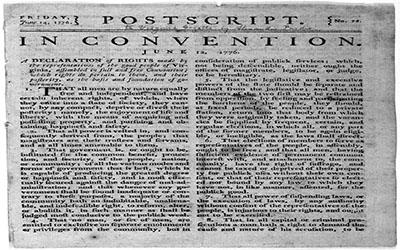
Description
The Virginia Declaration of Rights was drafted in June 1776 by George Mason. In it, Mason espouses the idea that all individuals are equal and have guaranteed rights. Virginia’s Declaration of Rights was the first document of its kind written by states and it…
Sojourner Truth, "Ain't I A Woman?," 1851
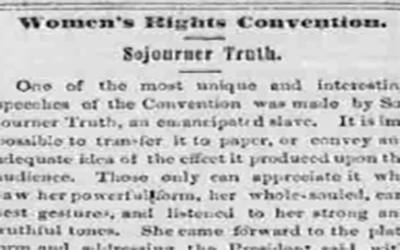
Description
Sojourner Truth, who escaped a life of enslavement, gave a speech at a Women’s Rights Convention in 1851. This transcription was printed a week after Truth spoke.
Declaration of Independence, 1776

Description
The Declaration of Independence is one of the founding documents of American history. The document declared that the American colonies of Great Britain were an independent country and listed all of the complaints the colonists had against British rule.…
The Ancient Rights and Liberties of Great Britain, 1849
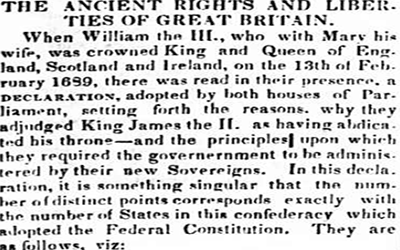
Description
In 1849, the Camden Journal, a newspaper from South Carolina, printed an article that quoted from the English Declaration of Rights of 1689. These are rights that settlers who lived in the British colonies in North America would have expected to enjoy. These…
The Federalist Papers, #84, 1788
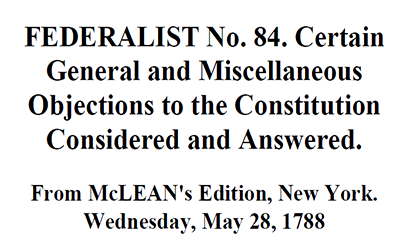
Description
The Federalist Papers were written by supporters of the United States Constitution. The Constitution had been drafted and approved by the Constitutional Convention during the summer of 1787. The final step to make the document the supreme law of the land…
Bill of Rights, 1791

Description
The Bill of Rights is the first 10 Amendments added to the US Constitution. The rights listed are guaranteed to all Americans. The Bill of Rights was introduced and passed by the First Congress. The Amendments were then sent to the states for ratification…
President Lyndon Johnson: Remarks upon Signing the Civil Rights Bill, 1964
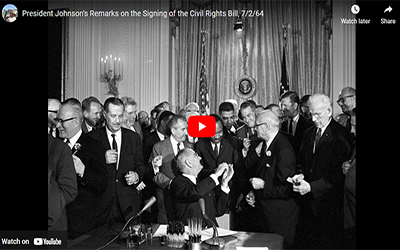
Description
Before signing the Civil Rights Act of 1964, President Lyndon B. Johnson addressed the nation. President Johnson discussed the importance of the law in relation to the founding concepts and beliefs of the United States. He put into context the importance…
An account of proceedings on the trial of Susan B. Anthony on the charge of illegal voting at the Presidential election in Nov., 1872
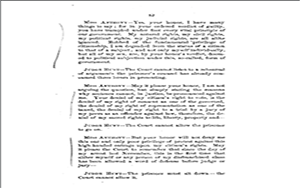
Description
In 1872, suffragist leader Susan B. Anthony attempted to vote in the presidential election. Knowing that it was illegal to vote, Anthony willingly accepted the risk of being arrested to further her cause for civil rights for women. At her subsequent trial…
Americans with Disabilities Act Anniversary, 2005 25:20 minutes - 27:45 minutes

Description
Iowa Senator Tom Harkin talks about the landmark Americans with Disabilities Act which was signed into law in 1990. Senator Harkin was the sponsor of the bill in Congress and was instrumental in gaining bipartisan support for it. The law has transformed…
Am I Not a Man and a Brother?, 1837
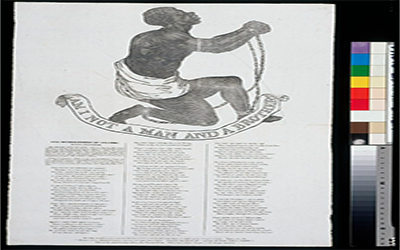
Description
The image of an enslaved male asking “Am I not a Man and a Brother?” first appeared in the 1780s in England. This broadside poster from 1837 includes a poem by John Greenleaf Whitter called “Our Countrymen in Chains.” Abolitionists used strategies like…
The Four Freedoms, 1943
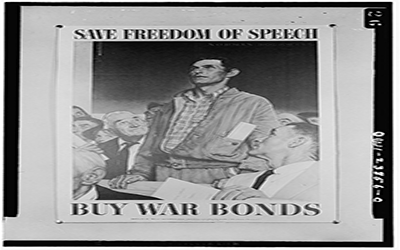
Description
In his Annual Message to Congress in January 1941, President Franklin Roosevelt outlined what became known as the Four Freedoms. In 1943, artist Norman Rockwell created four paintings depicting the freedoms President Roosevelt had highlighted in his speech.
Iowa Flag, 1918

Description
Dixie Cornell Gebhardt, from Knoxville, designed Iowa's state flag in the early 1900s. Gebhardt was a leader with the state's chapter of the Daughters of the American Revolution, which pushed for the formal adoption of a state flag by the Iowa Legislature during World…
15th Amendment, 1871

Description
This political cartoon was published in 1871. In the center, President Ulysses Grant signs the 15th Amendment which stated that the right to vote could not be denied to anyone on the basis of race or color. Surrounding the center portrait are several vignettes…
Additional Resources:
- Our Declaration: A Reading of the Declaration of Independence in Defense of Equality by Danielle Allen
A book by Danielle Allen that reinterprets American democracy through our founding text. - The Story of American Freedom by Eric Foner
A book by Eric Foner that traces American democracy from the revolution to modern times. - Liberty and Freedom: A Visual History of America's Founding Ideas by David Hackett Fischer
A book by David Hackett Fishcer explains how the ideas of freedom and liberty have changed over the coure of United States History. - The Goldfinch. Feb 1987
An article from The Goldfinch that examines "The Black Armband Case," of the Supreme Court case Tinker vs Des Moines that fought for the right to free speech in United States public schools. - Declaring Rights: A Brief History with Documents by Jack N. Rakove
A book by Jack N. Rakove that brings clarity to the United States founding documents.
Iowa Core Social Studies Standards (8th Grade)
Listed below are the Iowa Core Social Studies content anchor standards that are best reflected in this source set. The content standards applied to this set are middle school-age level and encompass the key disciplines that make up social studies for eighth-grade students.
| No. | Standard Description |
| SS.8.13 | Explain the powers and responsibilities of citizens, political parties, and the media in a variety of governmental and nongovernmental contexts. |
| SS.8.21 | Analyze connections among early American historical events and developments in broader historical contexts. |
| SS.8.24 | Critique primary and secondary sources of information with attention to the source of the document, its context, accuracy, and usefulness such as the Declaration of Independence, the Bill of Rights, the Constitution, Washington’s Farewell address, the Louisiana Purchase treaty, Monroe Doctrine, Indian Removal Act, Missouri Compromise, Dred Scott v. Sanford, and the Treaty of Guadalupe-Hidalgo. |